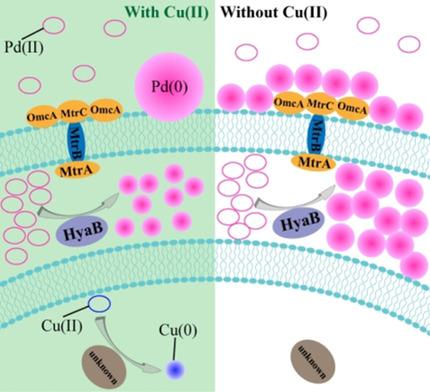当前位置:
X-MOL 学术
›
ChemElectroChem
›
论文详情
Our official English website, www.x-mol.net, welcomes your
feedback! (Note: you will need to create a separate account there.)
Effect of Copper and Phosphate on the Biosynthesis of Palladium Nanoparticles by Shewanella oneidensis MR‐1
ChemElectroChem ( IF 3.5 ) Pub Date : 2020-10-15 , DOI: 10.1002/celc.202001151 Zhiyong Zheng 1 , Yong Xiao 2 , Huili Cao 1 , Xiaochun Tian 2 , Ranran Wu 3 , Jingdong Zhang 1 , Jens Ulstrup 1 , Feng Zhao 2
ChemElectroChem ( IF 3.5 ) Pub Date : 2020-10-15 , DOI: 10.1002/celc.202001151 Zhiyong Zheng 1 , Yong Xiao 2 , Huili Cao 1 , Xiaochun Tian 2 , Ranran Wu 3 , Jingdong Zhang 1 , Jens Ulstrup 1 , Feng Zhao 2
Affiliation

|
The biosynthesis of metallic nanomaterials, especially noble metal nanomaterials, has attracted extensive attention due to the multifarious potential applications of these materials. In this study we have explored the effects of Cu(II) on Pd(II) removal, and of Cu(II) as well as phosphate on the morphologies and composition of biogenic nanoparticles (NPs) from aqueous Pd(II) systems by Shewanella oneidensis MR‐1 (MR‐1). Cu(II) causes a slight efficiency decrease of Pd(II) removal by MR‐1, but a high removal efficiency of 89.8 % is still achieved, which contrasts sharply with the significant Cu(II) inhibition to other microbes. Without phosphate buffer in the medium, 5‐nm PdNPs densely envelop MR‐1 and accumulate significantly in the periplasm in the absence of Cu(II), while 4‐nm PdNPs are evenly distributed in the periplasm, and the cellular surface is smooth in the presence of Cu(II). The following effect of Cu(II) on PdNP synthesis by MR‐1 is therefore proposed: Cu(II) significantly affects PdNPs morphologies by inhibiting Pd(0) transfer across the outer membrane and PdNP crystal growth in the periplasm, but not the sorption of Pd(II). Phosphate addition only slightly increases Pd harvest but also precipitates Cu(II) and poses difficulties for the biosynthesis. The study highlights the effect of co‐existing metals during the biosynthesis of metallic nanomaterials and offers new insight into the mechanism of PdNP formation and the electron transfer during Pd(II) reduction by MR‐1.
中文翻译:

铜和磷酸盐对Shewanella oneidensis MR-1生物合成钯纳米颗粒的影响
金属纳米材料,尤其是贵金属纳米材料的生物合成,由于这些材料的多种潜在应用而受到广泛关注。在这项研究中,我们探索了铜(II)对Pd(II)去除的影响,以及铜(II)和磷酸盐对Shewanella水溶液Pd(II)系统中生物纳米颗粒(NPs)的形态和组成的影响。奥尼迪斯MR-1(MR-1)。Cu(II)导致MR-1去除Pd(II)的效率略有降低,但仍实现了89.8%的高去除率,这与Cu(II)对其他微生物的显着抑制作用形成鲜明对比。在培养基中没有磷酸盐缓冲液的情况下,5-nm PdNPs紧密地包裹在MR-1中,并且在没有Cu(II)的情况下在周质中大量积累,而4-nm PdNPs在周质中均匀分布,并且细胞表面光滑Cu(II)的存在。因此,提出了Cu(II)对MR-1合成PdNP的以下影响:Cu(II)通过抑制Pd(0)穿过外膜的转移和周质中PdNP晶体的生长,但不吸附而显着影响PdNPs的形态。钯(II)。添加磷酸盐只会稍微增加Pd的收成,但也会沉淀Cu(II),给生物合成带来困难。该研究突出了金属纳米材料生物合成过程中共存金属的作用,并为MR-1还原Pd(II)期间PdNP形成的机理和电子转移提供了新的见解。
更新日期:2020-11-12
中文翻译:

铜和磷酸盐对Shewanella oneidensis MR-1生物合成钯纳米颗粒的影响
金属纳米材料,尤其是贵金属纳米材料的生物合成,由于这些材料的多种潜在应用而受到广泛关注。在这项研究中,我们探索了铜(II)对Pd(II)去除的影响,以及铜(II)和磷酸盐对Shewanella水溶液Pd(II)系统中生物纳米颗粒(NPs)的形态和组成的影响。奥尼迪斯MR-1(MR-1)。Cu(II)导致MR-1去除Pd(II)的效率略有降低,但仍实现了89.8%的高去除率,这与Cu(II)对其他微生物的显着抑制作用形成鲜明对比。在培养基中没有磷酸盐缓冲液的情况下,5-nm PdNPs紧密地包裹在MR-1中,并且在没有Cu(II)的情况下在周质中大量积累,而4-nm PdNPs在周质中均匀分布,并且细胞表面光滑Cu(II)的存在。因此,提出了Cu(II)对MR-1合成PdNP的以下影响:Cu(II)通过抑制Pd(0)穿过外膜的转移和周质中PdNP晶体的生长,但不吸附而显着影响PdNPs的形态。钯(II)。添加磷酸盐只会稍微增加Pd的收成,但也会沉淀Cu(II),给生物合成带来困难。该研究突出了金属纳米材料生物合成过程中共存金属的作用,并为MR-1还原Pd(II)期间PdNP形成的机理和电子转移提供了新的见解。











































 京公网安备 11010802027423号
京公网安备 11010802027423号